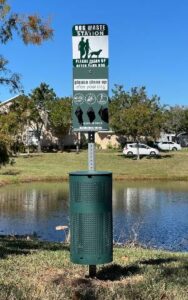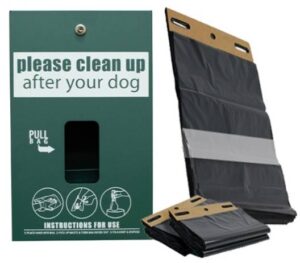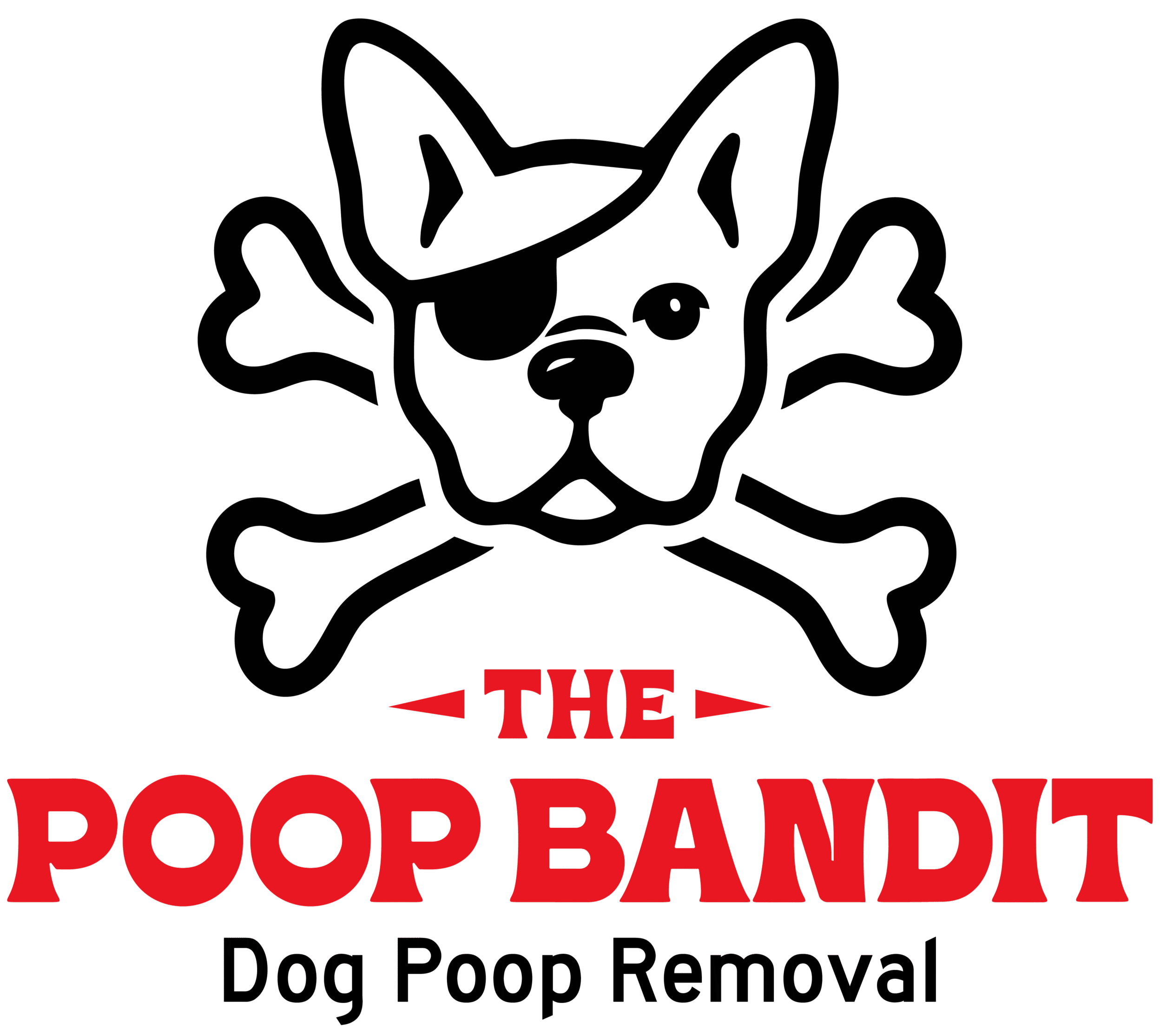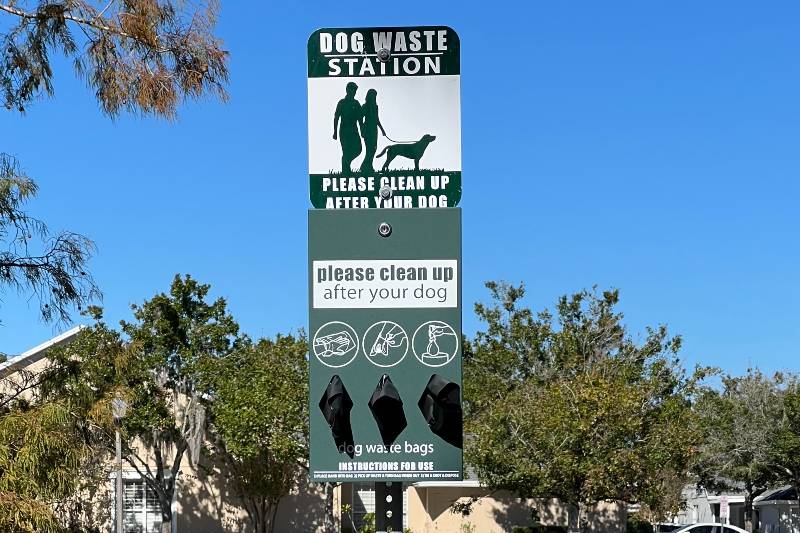By Michael Wright, Owner Operator of Poop Bandit – Dog Poop Removal
Many communities throughout Central Florida have resort-style amenities, such as walking trails, vast green areas, and dog parks.
One out of every three homeowners will own a dog.
A typical small dog of 25 pounds will produce 2 to 4 pounds of solid waste in one week, while large dogs over 25 pounds can produce 4 to 10 pounds of waste in one week.
Somewhere between 50% to 70% of owners will pick up after their dog.
Dog waste can cause significant health problems for humans and other pets. If not consistently picked up, dog waste can quickly become a substantial issue in large and small communities.
This is where pet waste stations can become a game changer in keeping your community clean. When pet waste stations are strategically installed throughout the community, it becomes much easier for residents to pick up after their dogs.
Where should pet waste stations be installed in your community?
- Pet waste stations should be installed in every dog park in a community to make it easier to keep these parks clean and disease-free for other dogs. Many diseases spread through dog waste, so keeping these play areas clean is crucial to ensure healthy dogs in your community.
- Any large green area should have pet stations installed nearby. These large green areas in communities often become “pseudo” dog park areas where residents will let their dogs play. A lot of the time, dog owners will not pick up poop left behind in these areas if there is not a pet waste station available for use.
- Many communities have extensive walking trails that are used daily. If residents don’t have trash cans on these paths to throw out trash, it typically will make its way to being left on the ground. The same is true of dog waste; if there are no pet waste stations in these areas, the dog poop will be left on the ground in many cases.
- Any high-traffic or highly used areas in communities should have pet waste stations installed nearby. Other areas that are candidates for nearby pet waste station installations are clubhouses, playgrounds, and mailboxes. Of course, don’t install them too close to these areas as they will likely become trash cans that will be too small to accommodate large items. For example, don’t install a pet waste station too close to mailboxes as they will quickly become overrun with mail and overflow frequently.
What types of pet waste stations are available?
Three main types of pet waste stations are available: plastic/fiberglass, steel, and aluminum. Each has pros and cons, but one stands out as the best solution for installations in Florida.
Each pet waste station, regardless of the material it is made from, comes in a roll bag dispenser version and/or header bag dispenser version.

- Plastic pet waste stations are typically the most cost-effective but face many challenges in the Florida climate. Anything plastic or fiberglass will quickly develop sun-rot and dry out. The damage can happen very fast and lead to plastic cracking, sometimes in a matter of months. Fiberglass can last longer, but when it fails, it turns very brittle and disintegrates, leaving shards of fiberglass and sharp edges that can become a liability to HOA communities if any residents become hurt by touching the units. The color also fades very quickly on these units and becomes an eye-sore.
- Pet waste stations made of steel or metal are heavily constructed and feel sturdy. They also hold paint very well to help protect them from the elements. However, these are typically not a good fit for the Florida climate for three reasons.-In Florida, we have an intense amount of rain, which breaks down steel and causes it to rust quickly.-The sun breaks down the protective paint on the steel units over time, leaving them vulnerable to water.-Almost every pet waste station is exposed to sprinklers daily. The mineral deposits left behind in the water corrode the paint on the units and the steel, causing it to rust and break down quickly.When you combine the amount of rain, minerals from sprinkler water, and the sun’s intensity on steel pet waste stations, they don’t stand a chance of lasting long-term.
- Aluminum pet waste stations have a major advantage over plastic and steel stations. They are sun-rot and rust-proof. Most aluminum pet waste stations are installed with a stainless-steel post, another high-rust and corrosion-proof metal.Aluminum pet waste stations typically use powder-coated paint, which gives them an excellent look. However, like our other two examples, the paint on aluminum pet waste stations will fade. Unfortunately, nothing can withstand the Florida sun 100% over the long term.
A note on landscapers: no matter what type of pet waste station you choose to install in your community, none of them will withstand being repeatedly hit by careless landscapers. Steel stations handle being hit the best by lawnmowers and are more challenging to dent. Aluminum is much softer than its steel and metal counterparts and dents much easier. Plastic stations with fiberglass posts don’t stand a chance versus lawnmowers.
You get what you pay for. Avoid purchasing the cheapest pet waste station on Amazon. They are inexpensive for a reason, typically because they are poorly constructed and made of inadequate materials. The locks on these units are also poorly made and quickly become problems.
What types of pet dispenser bags are used in pet waste stations?
There are two types of pet dispenser bags for pet waste stations.
 Type one is roll bags, like rolls of toilet paper, in that they tear off one bag (sheet) at a time. |
 Type two are header bags; these bags tear off like sheets of paper on a legal notepad. |
Both pet dispenser bags are typically the same approximate size of 8 x 12 inches.
Header pet dispenser bags are typically used up faster than their roll-bag counterparts. When tearing off the bag (sheet), the perforations on each bag easily give way, and multiple bags will come off.
Pet dispenser bags come in various colors and thicknesses. The thicker the bags, the higher the cost. However, most are made from high-density plastic, so they will not tear open when used.
How should pet waste stations be installed?
Most pet waste stations are not safely or correctly installed in communities. Like many items in the community, street signs, for example, are pounded into the ground as far as possible and left to hope they stay put for as long as possible. There are many reasons why items installed in the ground should not be done haphazardly and without care. What if a worker hits a gas line?
The proper steps to install pet waste stations or any item planted in the ground are:
- The installation areas should be surveyed by a qualified company that takes precautions and steps to ensure safe installation. All locations should be marked and white-lined with paint for 811 services to clear the location as a safe place to install.
- Contacting 811 services to mark any potential underground utilities is a must! The last thing an HOA needs is liability from workers hurt by piercing a water, gas, or electricity line.
- If possible, use a company with an Exactix-certified employee who is surveying the installation of pet waste stations to ensure safety.
- Only use installation companies that follow the manufacturer’s directions on how to properly install pet waste stations. Pet waste stations need to be assembled correctly and planted in the ground at least 14 inches with cement.
In Florida, pet waste stations should be planted in the ground deeper than 14 inches and filled with more cement than the manufacturer recommends, ensuring they are as weatherproof as possible. The last thing any HOA community wants is a loose pet waste station flying around in a hurricane or tropical storm.
Most companies do not follow these simple guidelines for installing items in the ground because doing it correctly takes time and costs more.
Michael Wright has been the Owner Operator of Poop Bandit – Dog Poop Removal Services since 2017. Poop Bandit services over 200 communities in Central Florida. He can be reached at mike@poopbandit.com and (407) 604-1008


